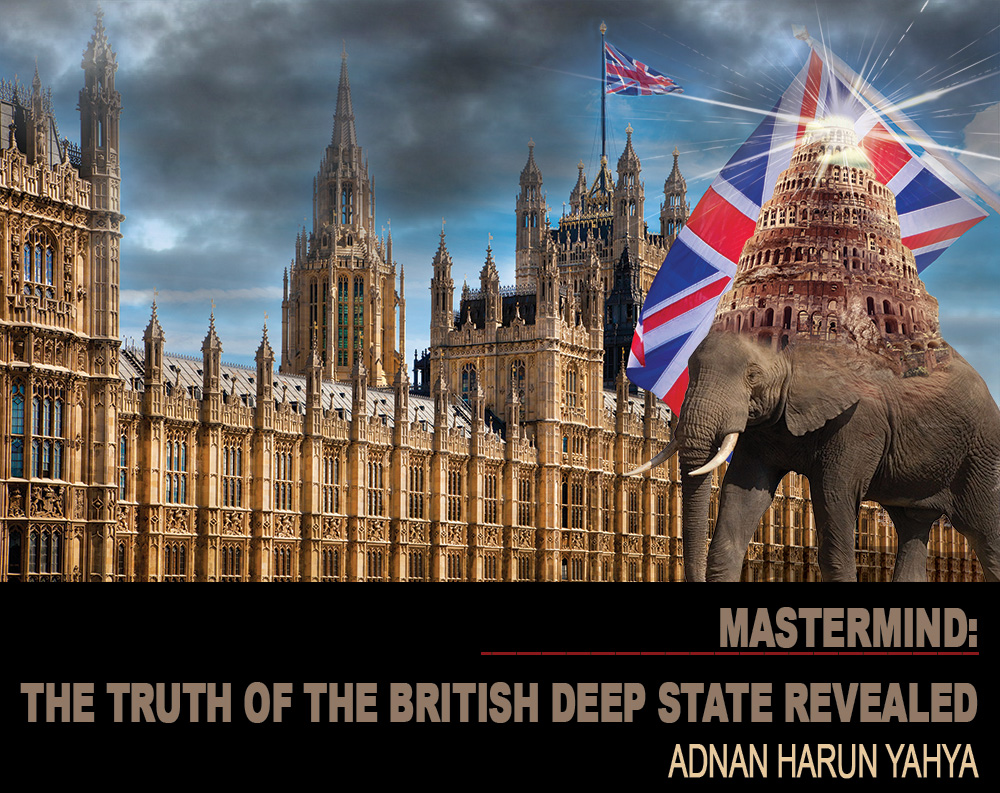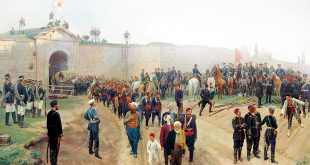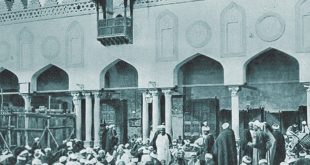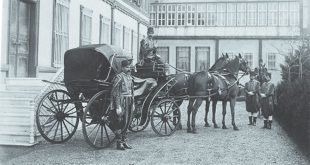Even though the Ottoman Empire had the world’s fourth biggest army and third biggest navy during the rule of Sultan Abdülaziz, it quickly lost power when Sultan Abdul Hamid II ascended to the throne. Let us recall one more time that Abdul Hamid II was kept under intense pressure from the British deep state when he was the Sultan. The intimidating military prowess that was built during Sultan Abdülaziz’s reign greatly concerned the British deep state. When another sultan came into power, whom they kept under pressure, the British deep state was able to get what they wanted. Using his own throne concerns and coup rumors as an excuse, Sultan Abdul Hamid II withdrew the impressive Ottoman Navy from use. He ordered that the ships be anchored at the Golden Horn, and left them there to rot.
The British First Lord of the Admiralty, the Second Earl of Selborne, who had inspected the condition of the Ottoman fleet during those days reported that ‘There was no Navy!’.137 The Ottoman submarine, the first in history to fire a torpedo while submerged, was left to rot in the Golden Horn. The Ottoman Empire, once the leader of the submarine race in the world, was now facing the prospect of entering WWI without a single one. An Empire that had written history ruined its own fleet at the instigation of the British deep state and entered the dreadful decade of constant wars that started with Balkan Wars of 1912 and ended with the Turkish War of Independence in 1922, without an army or a navy.
The appalling state of the navy became clear only when the Greco-Turkish war broke out in 1897. At the onset of the war, the officers planned a passage of the navy from the Golden Horn to Dardanelles as a tour de force. However, as soon as the movement started, three out of the eight boilers of the ironclad Mesudiye exploded, and the engine room of Hamidiye was flooded. The ships were supposed to meet off the shore of Yeşilköy, but a mere light drizzle was enough to cause them to get lost. Hamidiye went to Lapseki instead of Dardanelles, while the ironclad Hizber got lost. Two days later, she was found beached on the island of İmralı.138
Already without a navy at the onset of WWI, the Ottoman Empire once again fell for the games of the British deep state and never received the dreadnoughts Sultan Osman and Reşadiye from Britain, although it had fully paid for them. Clearly, the British deep state had long before plotted with detail how the Ottoman Empire should have been destroyed with WWI.
 |
| (1) The Ottoman Navy left to rot in the Golden Horn. (2) Submarines became useless after they were withdrawn to the Golden Horn and left to rot there. As a result, the Ottoman Empire had to join WWI without a single submarine. |
 |
| The ironclad Mesudiye became a part of the Ottoman Navy during the reign of Sultan Abdülaziz. However, it was left to rot during the reign of Abdul Hamid II. |
Turkey-Russia Rapprochement and Military Coups |
| After the start of normalization between Turkey and Russia, and the subsequent coup attempt on July 15, 2016, the Turkish and Russian governments stepped up their efforts to solidify their alliance. Both countries began working on common strategies with respect to regional issues, most notably those surrounding the Black Sea region and Syria.
This alliance, based on the fact that only indigenous nations can find solutions to regional problems, was a valuable step forward and had a real potential to bring the peace longed for by the entire world. This is certainly not the first time the two nations cooperated: in 1833, the Treaty of Hünkar İskelesi brought expansive military security to both nations. Ottoman Sultan Mahmud II and Emperor Nicholas I of Russia realized that such a treaty could block the plots of third party countries, especially of Britain. According to the treaty, if one side requested military assistance, the other would offer that help with all its resources. Furthermore, according to the classified clause of the treaty, in case of a war waged against Russia by a Western country, the Ottoman Empire would close the Dardanelles to all warships except for those of the Russian Navy. Although classified, the European states acquired the classified details with the help of John Ponsonby, the British Ambassador at Istanbul. The European threats of war and heavy political pressure resulted in the treaty being revoked by the London Straits Convention of 1841. Another example of the historical Russian-Ottoman rapprochement took place during the reign of Sultan Abdülaziz. The son of Mahmud II, Abdülaziz considered Russia a close ally and friend and started an alliance process. The Russian Ambassador to Istanbul, Nikolay Pavlovich Ignatyev, played a particular role in this process. However, once again, a group of pro-British officers staged a coup and ousted Sultan Abdülaziz. Unsurprisingly, the policies of the new Sultan, Abdul Hamid II, as well as Midhat Pasha and ‘English’ Said Pasha, caused another war between the Ottoman Empire and Russia, which ended with the death of 250,000 people. Similar plots and schemes continued throughout the 18th and 19th centuries and gave rise to a total of six wars. During these wars, European countries, led by the British, sometimes sided with the Ottomans and sometimes with the Russians. But they always prevented the two countries from being allies. The British deep state that incited, provoked and instigated wars, sometimes acted as the mediator in peace negotiations. Of course, the only winner of those peace negotiations was always the British deep state. Innocent people lost their lives, cities were destroyed and, as a result of British deep state plots, the two great empires, the Ottoman Empire and the Russian Empire, were lost to the pages of history. In the 20th century, Turkey once again received a helping hand from her northern neighbor Russia. For instance, it was the Russians that revealed the existence of the Sykes-Picot Agreement. And during the Turkish war of independence, Turkey enjoyed military and financial support from the Russians. Indeed, as a gesture of appreciation, statues of two Russian generals, General Mikhail Frunze and Marshal Kliment Voroshilov, were erected in Taksim Square, the heart of Istanbul, along with others that helped win the independence war. Russians once again helped Turkish industrial efforts during the first years of the Republic and contributed to the recovery of war-torn Anatolia. The young Turkish Republic, however, again fell victim to deep state plots, because whenever Turks started focusing on the friendship with Russia, civil unrest and military coups would ensue. Clearly, the British deep state didn’t like the friendship between Russian and Turkish people. In the 21st century, under the leadership of President Putin and President Erdoğan, both countries started an unofficial era of alliance in areas of policy, economy and trade. Mega projects were announced one after another as Russians and Turks enjoyed the comfort of this fruitful friendship. Even the regrettable plane-downing incident of December 2015 was not able to eclipse the solid friendship. In any case, it shortly became clear that sycophants used by the British deep state were behind the incident. Both nations greatly reaped the fruits of this friendship as they made sure that the countries continued alliance and were not fazed by outside provocations during that time. The leaders of the two countries, exercising sound judgment, strengthened their alliance and foiled the plots of the British deep state. Now, our biggest advantage is the awareness that the plotter is the British deep state. Knowing the identity of the so-called ‘mastermind’ will completely render ineffective any plots planned against the two countries. It should be remembered that empires that built great civilizations will never completely disappear. Indeed, today both countries enjoy sizable influence and power in their regions. As a matter of fact, with a Muslim population of 20 million, Russia today hosts a Muslim community that is larger than many Islamic countries. Considering the current power potential, it is obvious that only the Russian-Turkish alliance can bring real peace to conflict zones in the region. Therefore, it shouldn’t come as a surprise that some circles that feed on wars are targeting this alliance. Yet, the 230 million people of Russia and Turkey have the power to reinforce this alliance and further their common goals. |
Footnotes:
137. Michael Korda, Hero: The Life and Legend of Lawrence of Arabia, HarperCollins Publishers, New York, 2010, p. 246
138. Nejat Gülen, Şanlı Bahriye: Türk Bahriyesinin İkiyüz Yıllık Tarihçesi 1774-1973 [Honorable Navy: Two-Hundred-Year-Old History of the Turkish Navy, 1774-1973], 2001, Kastaş Publishing
 British Deep State MASTERMIND: THE TRUTH OF THE BRITISH DEEP STATE REVEALED
British Deep State MASTERMIND: THE TRUTH OF THE BRITISH DEEP STATE REVEALED



